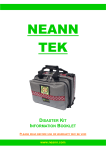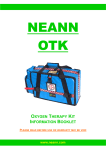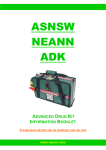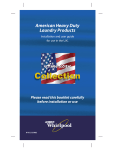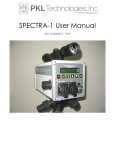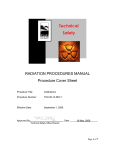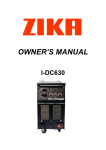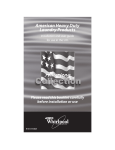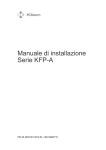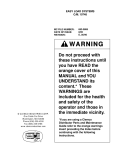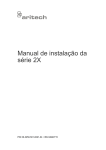Download 1. True or False - Banksville Independent Fire Department
Transcript
September 2013 OSHA Name: ___________________________ Signature: _________________________ Date: ____________ Topics: ‐ General Hazard Recognition, PPE, SCBA References: ‐ The Art of Reading Smoke (video); MS Firenet ‐ Donning the SCBA Facepiece, Scott SCBA User Manual ‐ BIFD OSHA Training ‐ Fire Behavior Terminology; Fire Engineering Weekly Drill #5 ‐ Turnout Gear Care and Cleaning Guidelines, Globe Instructions Directions: Review the attached materials and then answer the questions below. The completed quiz can be placed in the PCR mailbox located in the radio room. You can also record your answers on an email and send it to [email protected] . If you have any questions, please feel free to speak with an officer. 1. True or False: After donning the SCBA facepiece and tightening the neck straps, you should stroke the head harness net down and back to assure it is resting flat against the back of the head, and then re‐tighten the neck straps. 2. True or False: Warning signs of a flashover include smoke stained windows, smoke pushing under pressure, and no visible fire. 3. True or False: Flashover generally occurs during the growth phase of a fire. 4. True or False: When cleaning your turnout gear, the DRD should be removed from the coat. 5. True or False: If blood is splashed on your bunker pants, you should decontaminate 2692 them using a 10:1 water/bleach solution. 6. Monthly PPE Inspection: Inspect your turnout gear (coat, pants, helmet, gloves, hood, boots), bailout system and harness and initial below. _____ Inspection Completed. Describe below any items that have not been issued or that are in need of repair or replacement: September OSHA Video The Art of Reading Smoke – This 10‐minute video includes some nice demonstrations and visuals of various smoke conditions. The video can be viewed on the GFD Computer in the radio room, by clicking on the icon at the bottom of the screen underneath the CAD Times screen. You can also view it from any computer by clicking on this link: http://www.youtube.com/watch?v=cLBtRwJ93aQ SCBA Facepiece Donning While doing fit‐testing, I noticed some members didn’t assure that the head harness net was positioned properly. Failure to do this could result in the shift of the harness and a loss of the facepiece seal when donning the hood/helmet or while working in a hazardous environment. BIFD OSHA Training OSHA/PESH regulations detail specific safety and health training requirements for firefighters. NYS PESH specifically states that “… this training is not designed to make firefighters more proficient in firefighting, but is oriented towards firefighters’ personal safety and health”. The requirements include: Physical Examination Respirator Fit‐Test Participate in training at least quarterly and complete at least 8‐hours of safety and health training annually. The annual training program to include certain topics such as station safety, response safety, scene safety, hazard recognition, SCBA, PPE, tools/equipment, haz mat, and infection control. The BIFD Monthly OSHA training is intended to provide the required awareness‐level refresher topics in a consistent and timely manner, and in a manner that is available to all members regardless of their personal work, family, school schedules, etc. Completion of these on a monthly basis will address most of the annual topics and meet the quarterly training requirement. However, in order to meet the minimum 8‐hours and cover all the required topics, members must also complete the following by November 30th each year: Physical Fit‐Test Practical SCBA training Practical Bailout training Again, the above requirements are not designed to make firefighters more proficient. Proficiency – either as a firefighter or as a fire department – requires regular drills and hands‐on training. Even veteran members can benefit from attending drills … there is always new equipment and new techniques to learn about, and less experienced members to work with and train. Just like a sports team, drilling together will make us better prepared for “game time”. At the Rustling Lane fire, the initial crew that made entry and stopped the forward progress of the fire had worked together in many drills this year, and had just the previous week, drilled together stretching lines and attacking a fire. The training paid off. The Monthly OSHA’s are available 24/7 and place more responsibility on each individual member to complete. The hope is that members can find ½ hour each month to review and complete these regardless of their personal schedules, and thus have more availability to attend regular drills and apply the training in hands‐on, practical scenarios. Members who complete the above minimum OSHA requirements and attend other drills and training will far exceed the minimum OSHA/PESH requirements and help BIFD maintain a safe and proficient fire department. Weekly Drill Rollover - the least dangerous, it consists of escaping smoke and gases being ignited overhead, which will conn sume the fuel in the air very quickly and burn out. -Prepared by Russell Merrick/Firehouse.com For the most up to date news and training opportunities, visit www.Firehouse.com Care and Cleaning Guidelines GUIDELINES NFPA 1851, Standard on Selection, Care and Maintenance of Protective Ensembles for Structural Fire Fighting and Proximity Fire Fighting, has led to an increased awareness among firefighters for the need to have turnout clothing laundered regularly. The Globe label on every garment provides very basic information for laundering; however, what follows is a much more comprehensive set of instructions for cleaning gear. • • If the liners and/or the DRD are detachable, they should be removed from the shell and laundered separately. This is to prevent any contaminants on the shell being transferred to the inner portions of the garment during the laundering process. It is also recommended that you turn the liner inside out prior to laundering to facilitate the drying of the inner layer. All closures should be fastened: Hook and loop hook tape covering hook and loop pile, hooks and dees fastened, zippers zipped and snaps fastened. It is imperative that you cover the hook portion of all hook and loop to prevent snagging during laundering and to help guard against premature wear. Machine Washing: We are often asked if machine washing could affect the protective qualities of your turnout gear. The special fabrics that make up your turnouts contain inherent flame and heat resistance properties, which cannot be washed off or worn out. However, given the nature of the contaminants to which firefighters are exposed, you should never, never use the same machine that you do your home laundry in. When machine washing, always prepare the clothing as directed, by separating removable liners and DRDs from outer shells and fastening all closure systems. Use warm water and a normal cycle; water temperature should not exceed 105°F. Following each complete wash cycle, thoroughly rinse your garments. Liners should be turned inside out, while DRDs should be laundered in a mesh bag; every separable component should be laundered separately. Protective clothing should always be washed by itself; do not overload the washing machine, do not use softeners, and NEVER use chlorine bleach. Our recommended method of drying is to hang in a shaded area that receives good cross ventilation or hang on a line and use a fan to circulate the air. Naturally, the turnout system will dry more quickly if you separate the layers for laundering and turning the liner system inside out will facilitate drying of the quilt thermal barrier. Cleansers: Cleansers generally fall into two categories, detergents and soaps. Of the two, detergents make the best cleansers because they are formulated to contain special agents that help prevent redeposition of soil. Soil redeposition is soil which is first removed from a laundered article, but later in the same wash cycle is redeposited as a thin soil film on the entire surface of the article. The most distinctive advantage of detergents is that they do not form curd in hard water. Soap curd is the material which forms a ring around the bathtub when bathing with soaps, and this curd is extremely difficult to rinse out of your garment. All cleaning agents are clearly labeled as being either detergents or soaps; and we recommend liquid detergents, since they are less likely to leave any residue on the clothing. It should also be noted that NFPA 1851, Standard on Selection, Care, and Maintenance for Structural Fire Fighting and Proximity Fire Fighting Ensembles requires that cleaning and contamination solutions shall have a pH range of not less than 6.0 pH and not greater than 10.5 pH. Spot Cleaning and Pretreating: Precleaners can be used to clean light spots and stains on protective clothing. Squirt the precleaner onto the soiled area and gently rub fabric together until a light foam appears on the surface; this foam should be completely rinsed off with cool water prior to washing. A soft bristle brush, such as a toothbrush, may be used to gently scrub the soiled area for approximately one to one and a half minutes. An alternative method would be to pretreat garment by applying liquid detergent directly from the bottle onto the soiled area and proceed as with precleaners. Any spot cleaning or pretreating should be followed by machine washing prior to field use. Bleach: One of the most often asked questions concerns the decontamination of a turnout system, especially with chlorine bleach. UNDER NO CIRCUMSTANCES should chlorine bleach be used on firefighters' clothing; most systems contain KEVLAR®, either as a blend or as the primary fiber, and KEVLAR® is extremely susceptible to damage when exposed to bleach. Trim: 3M, the manufacturers of both SCOTCHLITE™ and Triple Trim, recommend that the following guidelines be used for their product: (1) Damp wipe, using warm water not to exceed 105°F, and mild detergent. Rinse thoroughly, dry with a soft cloth, or allow to air dry. (2) If you choose to machine wash, use warm water. (3) Do not dry clean. These instructions are equally effective for REFLEXITE® products. Decontamination: For extreme contamination with products of combustion, fire debris or body fluids, removal of the contaminants by flushing with water as soon as possible is necessary, followed by appropriate cleaning. In the case of bloodborne pathogens, recommended decontamination procedures include using a .5 to 1% concentration of Lysol, or a 3-6% concentration of stabilized hydrogen peroxide. Liquid glutaraldehyde, available through commercial sources, will also provide high to intermediate levels of disinfectant activity. The current edition of NFPA 1851 states that if a garment is verified as having been exposed to chemical, biological or radiological agents, that garment should be immediately removed from service and retired. When decontamination is not possible, the garments should be discarded in accordance with local, State and Federal regulations. Garments that are discarded should be destroyed. How Did You Do? 1. TRUE 2. FALSE Smoke stained windows, smoke pushing under pressure and no visible fire are signs of a potential backdraft. 3. TRUE 4. TRUE 5. FALSE Bleach should never be used.







